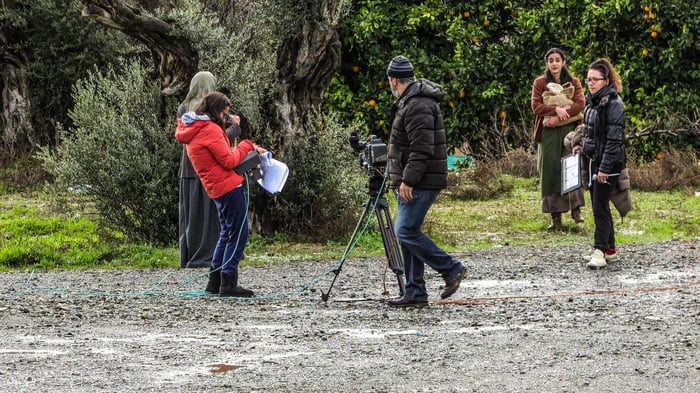In the world of film and television production, every dollar counts. Earlier this year, Glyph's home state of New York revamped its production tax credit program to entice more productions to take place in the empire state. From scouting locations to hiring crew and post-production, expenses can quickly add up. That's where production tax credits come in – a powerful tool that can significantly reduce the cost of bringing your creative vision to life. But if you're not deeply immersed in the world of production finance, understanding these incentives can feel like decoding a complex script.
This post is for you, the dedicated producers, line producers, and production managers working tirelessly to create captivating content. We're going to break down what production tax credits are, how they work, and, most importantly, how you can access them to maximize your project's financial efficiency.
What Exactly Are Production Tax Credits?
At their core, production tax credits are incentives offered by state and sometimes local governments to encourage film and television production within their jurisdiction. Think of them as a rebate on eligible expenses incurred during your project. These credits aim to stimulate economic growth by bringing jobs, tourism, and infrastructure development to the areas where production takes place.
It's important to distinguish them from direct grants. While grants provide upfront funding, tax credits are typically applied against a company's tax liability or, in many cases, can be sold to other entities for cash. This "monetization" aspect is crucial for productions that might not have a significant tax burden themselves.
How Do Production Tax Credits Work?
The mechanics of tax credits vary significantly from state to state, making it essential to do your research. However, a general framework applies:
Eligibility Requirements
States set specific criteria for productions to qualify. These often include:Minimum Spend: A certain amount of money must be spent within the state.
Eligible Expenses: Not all expenditures qualify. Generally, expenses like local crew wages, equipment rentals from in-state vendors, set construction, and local lodging and catering are eligible. Above-the-line talent wages may have limits.
Filming Days: A minimum number of shooting days within the state might be required.
Content Creation: The production must be a feature film, television series, commercial, or sometimes even a documentary.
Application Deadline: There are often strict deadlines for applying before or during production.
Credit Percentage
Each state offers a different percentage of eligible expenses back as a credit. This can range from 15% to 40% or even higher for certain types of expenditures (e.g., visual effects).Transferability/Refundability
Transferable Credits: These can be sold to other businesses or individuals with a tax liability in that state. This is how many productions, especially independent ones, "cash out" their credits. There's typically a market for these, though they are usually sold at a slight discount.
Refundable Credits: Less common, these credits can be directly cashed out by the state if the production doesn't have enough tax liability to use them.
Non-Refundable/Non-Transferable: These can only be used by the production company against its own tax liability in that state. While less flexible, they can still offer substantial savings for large studios with significant tax burdens.
Application and Audit Process
Once production is wrapped and expenses are tallied, a detailed application is submitted to the state's film office or relevant tax department. This often involves a thorough audit of all eligible expenditures to ensure compliance.
How to Get Them: Your Action Plan
Securing production tax credits requires meticulous planning and a proactive approach. Here's a step-by-step guide:
Research, Research, Research:
Identify Target States: Based on your script, budget, and creative needs, research states with robust incentive programs that align with your project. Websites like Entertainment Partners New York Resource page or individual state film commissions are excellent starting points.
Understand Specific Rules: Dive deep into the nuances of each state's program. What are the minimum spends? What expenses are eligible? Are the credits transferable or refundable?
Look for Caps and Sunsets: Some programs have annual caps on the total amount of credits awarded, and incentives can change or "sunset" (expire).
Early Engagement is Key:
Contact the State Film Office: As soon as you're seriously considering a state, reach out to their film commission. They are an invaluable resource for clarification on rules, application procedures, and local vendor connections.
Consult a Tax Credit Advisor/Broker: These specialists live and breathe production tax credits. They can help you navigate complex regulations, estimate your potential credit, and connect you with buyers if your credits are transferable. Their fees are typically a percentage of the credit received.
Budgeting for Credits:
Create a Detailed Budget: Work with your line producer to develop a granular budget that clearly delineates in-state eligible expenses. This will be critical for your application.
Factor in Credit Value: Incorporate the potential tax credit into your financing model. Remember, this is usually a reimbursement, not upfront cash, so plan your cash flow accordingly.
Meticulous Record Keeping:
Document Everything: From payroll records and vendor invoices to location permits and travel receipts, every eligible expense must be meticulously documented. Organize your financial records with future audits in mind.
Segregate Expenses: Keep eligible in-state expenses separate from non-eligible or out-of-state costs.
Application and Audit:
Submit a Strong Application: Ensure your application is complete, accurate, and submitted within the specified deadlines.
Prepare for the Audit: Be ready to provide all requested documentation to the state's auditors. A well-organized financial system will make this process much smoother.
The Bottom Line
Production tax credits are more than just a bonus; they are a sophisticated financial tool that can significantly impact your project's viability and success. By understanding how they work and diligently preparing, you can unlock substantial savings, allowing you to invest more in creative elements, attract top talent, and ultimately bring your storytelling to an even wider audience. So, next time you're mapping out your production, remember to put tax credits squarely in your sights - they might just be the key to your next big success.





